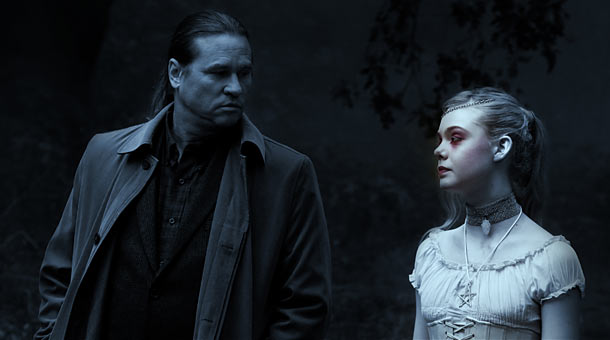
A few interesting moments here and there don’t salvage the messy, amateurish quality that runs throughout the film.

A few interesting moments here and there don’t salvage the messy, amateurish quality that runs throughout the film.
Francis Ford Coppola, who has been on an experimental kick with films like Tetro and Youth Without Youth, returns to the horror genre with Twixt. Directed, written, produced and financed by Coppola himself, Twixt is clearly a personal project right down to its shooting locations on Coppola’s own estate. While seeing Coppola make a return to form after his apparent banishment from Hollywood would have been ideal, Twixt is baffling throughout.
The film starts with a narrator (Tom Waits) introducing the small town setting and storyline. The town has several distinct features, including a broken clock tower with seven faces and a mass murder that no one likes to talk about. Hall Baltimore (Val Kilmer), a writer who is described as “third-rate” and a “bargain basement Stephen King,” arrives to sell copies of his newest book. Baltimore is trying to think of a new idea that’ll put him back on top but keeps coming up short until the town’s sheriff (Bruce Dern) shows him the corpse of a girl who was staked in the heart. The same night Baltimore has a dream involving a young girl named V (Elle Fanning) and Edgar Allen Poe (Ben Chaplin) that convinces him to stay and try to write a new novel.

Anyone going into Twixt expecting an easy time is setting themselves up for disappointment. There are at least three storylines going on in the film involving the mystery behind whoever staked the girl, the dreams that explain the town’s history and the novel being written by Baltimore in the film. Twixt switches back and forth between all three of these, with the only distinction coming in the form of the black and white imagery of Baltimore’s dreams. Distinguishing reality from fiction seems easy at first, but by the final act everything blurs together so much Twixt becomes a tangled mess of a film.
The confusing nature of the plot isn’t even the worst thing about Twixt either. Coppola, shooting the film on what appears to be consumer grade cameras, makes everything look cheap and inept. The use of colour in the black and white dream sequences (mostly reserved for reds) looks hokey, and a subplot involving a boy who might be a vampire (Alden Ehrenreich) is downright laughable. Some of the worst examples are when Edgar Allen Poe’s face is superimposed on to the moon and when Ehrenreich rides a motorcycle with a CG background that would look impressive over 20 years ago.
Val Kilmer luckily has enough talent to pull off a good performance as Baltimore, but the same can’t be said for others in the cast. Elle Fanning mostly looks lost at sea, but it’s understandable why she’d have a hard time considering how bizarrely awful the rest of the film is. Alden Ehrenreich doesn’t say much outside of one scene but he does manage to show off some seriously stilted delivery before driving off on a motorcycle. Ben Chaplin and Bruce Dern manage to walk away mostly unscathed, with Dern’s hammy performance heightening some of the film’s similarities with David Lynch’s work.
The incompetent way that Twixt is shot might have been done intentionally by Coppola to match the pulpy B-movie storyline, but the result is laughable. It’s unsurprising that Coppola shot the majority of Twixt on his own estate because, for the most part, it feels like someone messing around in their backyard. A few interesting moments here and there don’t salvage the messy, amateurish quality that runs throughout the film. If this is Coppola experimenting, then the result is a complete failure.